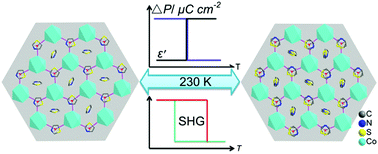Switchings of dielectric constant, second harmonic generation and polarization in a polar hybrid cyanometallate crystal†
Abstract
Compounds showing multi-switchable properties represent a type of new multi-stimuli responsive material that would find some promising applications. In this study, an organic–inorganic hybrid crystal (TA)2{(H3O)[Co(CN)6]} (1, TA = thiazolium) with a two-dimensional network constructed by the [Co(CN)6]3− anions and the hydronium cations via hydrogen-bonds was synthesized. 1 undergoes a structural phase transition between two polar phases at about 230 K due to the order–disorder transition of the TA cation. Detailed characterization, including variable-temperature structural analyses, differential scanning calorimetry (DSC), second-harmonic generation (SHG), dielectric and pyroelectric measurements, indicate that the local structural changes trigger multi-switchable properties of the dielectric constant, SHG and polarization. The discovery of multi-switchable responses based on polar compounds might provide a good strategy to search for new promising materials for smart switches.



 Please wait while we load your content...
Please wait while we load your content...